@Lost_N_BIOS @petergunn - The provided BIOS test file, redux.bin, has been flashed and tested. Everything appears to function properly and normally, with one small exception…any graphics card plugged into either x16 PCI-e slot will not initialize/activate during POST, but does turn on once the OS environment fully loads; this was tested in Windows and Linux OS environments, and both experienced the same behavior. However, upon I/O and IRQ debugging, I believe this behavior is to be expected, as both the NVMe module and graphics module appear to be contending for the same resources at initial boot time; I/O Range (D000 - D07F) and IRQ 0xFFFFFFE2 (-30). Once the OS takes over, it renegotiates the I/O and IRQ conflicts by reassigning the graphics card, making it appear to the OS as newly installed hardware. This behavior was only seen at the first reboot after flashing, but without an NVMe drive to test with, I can’t say for certain that it wouldn’t happen at every subsequent reboot as well.
Sorry it took me a while to report back, but I wanted to make sure my testing was thorough and complete.
Regarding my own BIOS and any previous BIOS region dumps, unfortunately I no longer have any, as they were lost when my original backup drive died ![]() However, using petergunn’s test file for reference, I might be able to add the data back to my BIOS, assuming the referenced locations are the same in both. Thanks, I’d appreciate the Dell engineer tool package. I may already have a copy of these tools, but it never hurts to make sure. I’m somewhat of a hoarder of tech tools/software…you never seem to need them, until you don’t have them, lol.
However, using petergunn’s test file for reference, I might be able to add the data back to my BIOS, assuming the referenced locations are the same in both. Thanks, I’d appreciate the Dell engineer tool package. I may already have a copy of these tools, but it never hurts to make sure. I’m somewhat of a hoarder of tech tools/software…you never seem to need them, until you don’t have them, lol.
Please let me know if there’s anymore testing either of you would like me to do, or if there’s anymore test files you’d like me to try.
Happy New Year to you both!
@millertime - that may expected with this mod/BIOS (ie nothing we can do), or may be IRQ related as you mention and could possibly be solved with some IRQ changes.
Brick or not was my main concern, everything else is standard for this mod I believe, some systems may need to adjust stuff in BIOS background as you noted (IRQ re-arrange etc)
So, it may be normal stuff to happen on first run/boot. To confirm, on reboots it doesn’t happen correct, and graphics cards load properly the entire time?
Thank you, I appreciate your extended testing! If you don’t mind, I’d like to send you another BIOS to test as well, to see if same edit done other way also works and also has same issues etc. Would you test another?
Ahh, sounds like you would be OK to test one more BIOS, PM Sent, if/when you have time, thanks! 
Yes, we can use his BIOS as reference to fix your service tag serial, asset tag etc, if you can’t get it with the tools. The padding thing I mentioned though, we may need to sort through deeper than a simple copy from other BIOS, since all BIOS I looked at vary widely.
Here’s the Dell tools, you probably already do have, A209 is not same as Asset, so be sure to try both if one does not work for you - https://ufile.io/lwr0v0an
Thanks, and Happy New Year to you and your family as well 
@Lost_N_BIOS - Correct, on subsequent reboots it doesn’t happen, and the graphics card fully initializes at POST. But it may not be happening on subsequent reboots due to the OS detecting and writing back to the EFI system partition that my current boot drive is non-NVMe, thereby “soft” disabling that boot option until the EFI SP is presented with an NVMe boot device…just a theory, but it seems plausible, especially with how the EFI SP is post-boot aware and writable.
You’re welcome, no troubles at all. I’ve flashed redux2. Everything appears to be functioning properly and normally, and this time, there were no issues with the graphics card initializing during POST, including with the first reboot after flashing. I also see no indications of I/O or IRQ conflicts of any kind. What’s the difference between redux and redux2?
Thank you for the tools! It looks like I should be able to add the motherboard serial info back using A209!
@millertime - thanks for your additional tests and info. So, from what you’ve experienced, do you think redux2 functions better, did not have that graphical issue at first.
Difference between redux and redux2 is redux2 I allowed a padding file to be added mid-edit, which i usually work around so it doesn’t happen and file matches initial dump, because often added or removed padding = brick.
In this case, padding was not there in user dump, so already previously removed from some edit or thing, but it is there in the stock BIOS, so seems this system functions OK with or without this particular padding, but in the case of NVME insert it’s best to leave the padding add-back and not work around it.
Thanks again for your testing! 
Asset Tag is what you really need to add back in, but I guess serial too if it’s not showing up for you. I think with those tools you may also be able to invoke/allow direct key-in entry of details at the BIOS level too, I can’t remember for sure, it’s been a while since I’ve used them.
I already added serial into the padding we’ve been discussing, but that may not be where system apps/BIOS pulls the data from, usually that would be in main BIOS volume which was corrupted
@petergunn - here is your NVME Mod BIOS - https://ufile.io/g03cuk9l
Put jumper on, reboot to windows twice, then flash via >> FPTw.exe -f spinvme.bin
Then, here, follow all steps exactly at #4 in the “This is what you should do” section here
[Guide] How to get full NVMe support for all Systems with an AMI UEFI BIOS
Gentlemen!
I’m happy to let you know the modified BIOS worked like a charm!
Backed up the contents of my SATA SSD, then restored it to the new NVMe drive (Sam. PM961) using Veeam.
Did not even have to disable Secure Boot or do really anything in BIOS after the restore process/rebooting the system!
According to Crystal Disk Mark the NVMe does 2400-2500 MB/s reads and 1600-1700 MB/s sequential writes (read speeds used to be over 3300 MB/s when it was just a secondary drive but its still a major improvement)!
What else can I say except for thank you again for your time and professional services!
Cheers,
Peter
@petergunn - So you already were using GPT/UEFI boot on your SSD? I guess so 

Thanks again to @millertime for advanced testing on your BIOS before I sent your way too
Sounds like something may be off, due to those speed hits (you may want to clean install). Speeds should be similar to what it was when spare, unless you are heavily using the drive while also benchmarking it
Please run AS SSD benchmark and show me image, download is tiny box/package at very bottom of page
https://www.alex-is.de/PHP/fusion/downlo…p?download_id=9
Also, download CrystalDiskInfo and select the drive, then show me image.
https://crystalmark.info/en/software/crystaldiskinfo/
What PCIE type is the slot you are using, and what width?
Also, if your drive manufacturer has a utility, install it and see if it offers a clean/TRIM function (NOT wipe)
You’re welcome 
Yes Indeed, I was already using GPT/UEFI!
The NVMe drive in use is a Samsung PM961 (this would be the OEM version for 960 EVO, as far as I understand) it is seated in a Dell Ultra-Speed Drive Quad NVMe M.2 PCIe x16 Card. The card itself is in a PCIe 3.0 x16 slot (no. 5 on picture).
AS SSD:
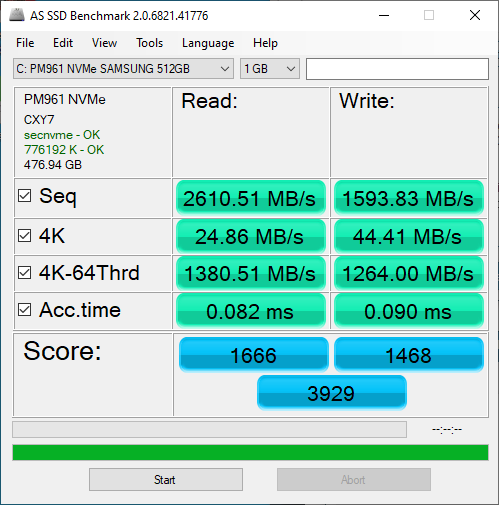
Crystad Disk Info:
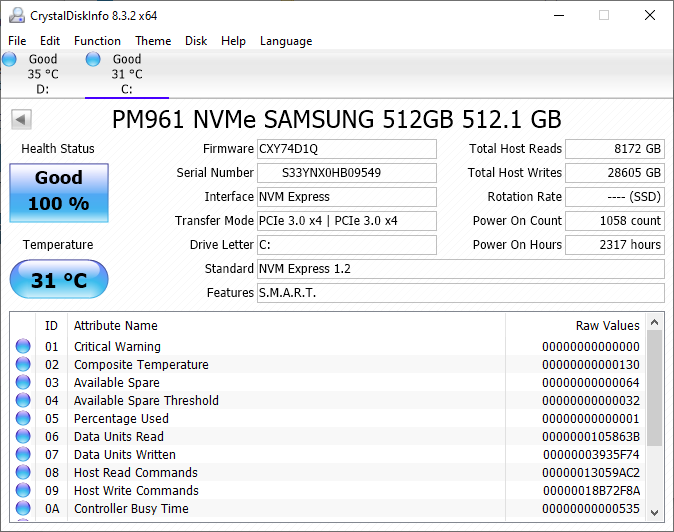
Also, TBW and Power On values also seem to be off. Power On does not seem to change despite power cycles.
System was idle while testing, so yeah…something does seem to be off.
Well, I still have the backup of the system, so I can safely destroy this installation…I’ll give it a try!
Samsung does offer a tool for their SSDs, called Magician, but since this is an OEM drive, most of its features are disabled
Thanks. Drive is aligned, so it’s not that. And you’re running 3.0.@ x4 so it’s not a lane speed or width issue
What driver do you have installed, and why? I don’t recognize SECNVME, and drivers can cause a huge difference in performance.
The SMART data may just not be detected properly, only way to be 100% sure it’s valid is if the drive manufacturer has put out a specific application for their NVMEs
Test a clean install and see if that helps. If you do this, I’d secure erase the drive first, that way you ensure it’s reset, since you can’t issue a TRIM command with Samsung’s tool
My mistake, it does seem to count Power On times and TBR also increased by 2GB after restart.
Anyhow, the drive is practically new (warranty replaced, only been tested since). I guess there is some offset in reported SMART data.
Well, I tried to update the default Windows 10 drivers with the official Samsung NVMe drivers before, but it did not seem to change from stock drivers according to Device Manager. Have no idea where secnvme came from
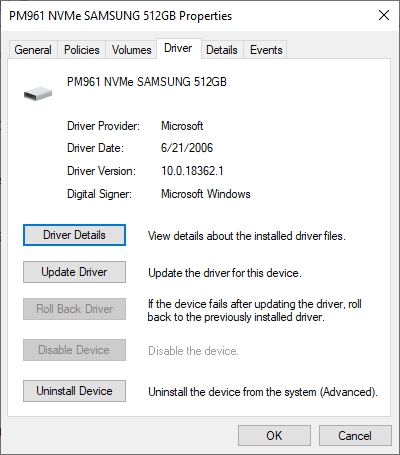
I’ll get back once done a clean install!
It looks I’ll have to do a proper clean install…redo all my config will be a pain.
Crystal Disk Info - after clean install
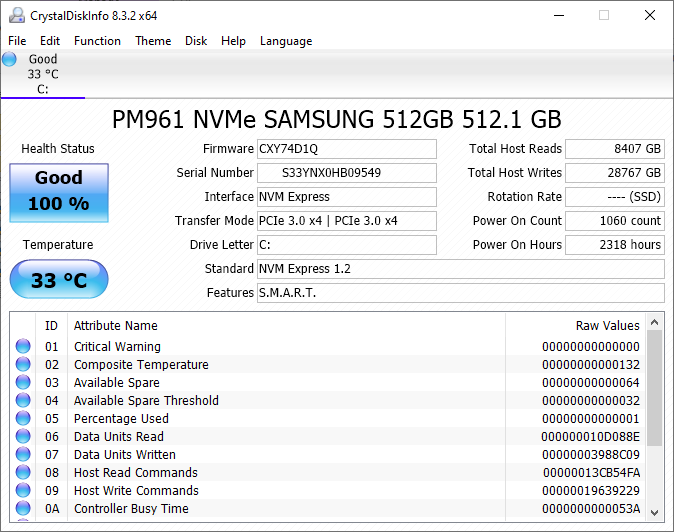
Crystal Disk Mark - after clean install

AS SSD - after clean install
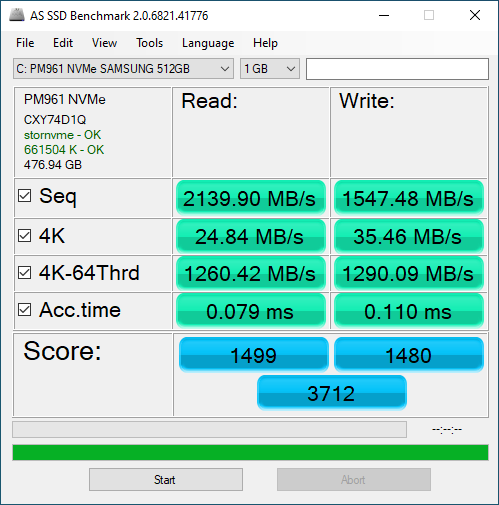
Thanks again and happy new year!
@petergunn - Samsung drivers were worse for me, with another drive. You’d have to check out the NVME driver area for all the possible NVME drivers and their performance tests Fernando did
I went back to standard Windows driver and found it to be best, but I did not compare with Intel ones.
Clean install CDM results look much better above  That may be due to the windows driver?
That may be due to the windows driver?
So before you do clean install, you could test removing the Samsung driver and see if putting back the default windows one helps, maybe then you wouldn’t need to do clean install.
Happy New Year to yo as well 
Hi there - I am looking for getting NVMe working on my T3610 as well … but reading through this thread, I am more confused as before ^^
@Lost_N_BIOS seems to have created a working one?
I have a few open questions:
- Is it possible? seems like in here
- Can I download and use some bios file from here? (same link as above, or is there something newer?)
- Does it work with the bios’s integrated (?) flash tool?
- Do I loose any of the internal data like config options and asset/service tags?
- where do i get the FPTw.exe from, and where should the jumper be located on the MoBo?
Sorry for my noob-invasion on this thread, trying to puzzle the pieces together (for 2 weeks by now)
Thanks for any insights you could give me on this
Any1?
Hello everyone, Im also ended up crasing the BIOS while playing with NVME boot on Dell T3610.
Clover USB boot worked fine, but wanted to boot directly from Toshiba XG6, and flashed a modded bios with FPTW.exe
I dont remember exactly, but after enabling secure boot, screen stayed blank. None of the reset methods helped.
So I ordered CH341 programmer, and clips for 8 & 16 pins soic (could remove & solder back, but this is really nice toy and makes things easier, especially if you have to program multiple times)
Of course, before programming took backup, but lost my original files due flash drive error ![]()
So I tried the modified BIOS here, made by Lost_N_BIOS for petergunn (SPINVME.bin), splitted to 8 & 4 MB and wrote. Best if you erase and write after. But still no display with this.
I found an T3610 backup somewhere on the net, browsing while waiting for the CH341
Also splitted, and finally display came back!
Still no NVME boot support, I can see the XG6 put on PCI excpress card as mass storage.
@BAcide
heres the splitted files to start with, at least you can use the computer again
8MB part is the first region of the 12MB dump, as tried both version ![]()
https://drive.google.com/open?id=1jDuuMa…Y9Hb_WV1wx_t14v
but if spent already a lot of time recovering system, would be great to finally succeed with NVME booting.
Any help from the masters welcome! ![]()
thanks, Peter
hello millertime,
may I get this version - redux2 to get nvme boot support? If Lost_N_BIOS doesn’t mind of course ![]()
I lost my original asset tag / serial but dont mind, have own windows key and dont plan to sell this machine.
thanks in advance
Hi, thank you for upload of Bios Dumps. What did you used to flash 8MB Bios part? CH341? Which clip?
I suggest you follow his suggestion to get a dump of the BIOS rom, then add NVMe driver with UEFITool.
Not possible as the mentioned user hasn’t logged since January 2021.
Follow the thread posts and start working, locate the ME jumper, dump, mod and flash.
Keep in mind that available dumps/mods contains original/specific motherboard data (UUID, MAC, SN etc…) …not your own.
[HowTo] Get full NVMe support for all Systems with an AMI UEFI BIOS

